Press/Review

Review by www.queensbuzz.com (Michael Wood)
http://www.queensbuzz.com/lic-jazz-festival---queens-cms-560
“The trio performs Brazilian influenced jazz, which has a calypsonian rhythm.The jazz trio included Hiromi doing the vocals, Hiroya Tsukamoto playing guitar and Keita Ogawa playing percussion and drums. Hiromi’s voice was silky, soft and soothing; and with her accompaniment, they sambaed us down to the islands.”
Hiromi Suda Trio
Performing in Long Island City Jazz Festival at The Secret Theatre
March 28th 2010
Hiromi Suda(Vocal)
Hiroya Tsukamoto(Gt.)
Keita Ogawa(Percussions)
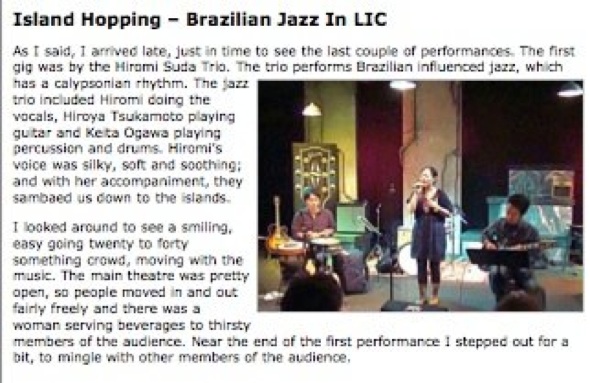
Magazines and Newspapers (Interviews and reviews about new album “Sou”)
The New York City Jazz Records October 2012
Magazines:
Oz Magazine p.122 (Aug. 10th 2012) http://www.ozmall.co.jp/ozmagazine/
Jazz Life p.82,98 (Aug. 11th 2012)
Sunday Mainichi (Interview) (Aug. 28th 2012)
LaTina p.98 (September 2012)
Music Magazine p.181 (September 2012)
intoxicate p.22(Interview) (Aug. 20th 2012)
Jazz Life 9/14 (Interview)
Jazz Japan 9/2012
Newspaper:
Yamanashi Nichinichi Newspaper (Bunkura) 8/28”(Interview)
Tokyo headline (Aug. 27th 2012)
In the Vox News column for the Cornelia Street Cafe "Sou" CD release show published in the edition of The New York City Jazz Record.
“From Tokyo, Hiromi Suda will release her CD of Brazilian songs and Brazilian-influenced originals Sou (Happiness) at Cornelia Street Café (Oct. 9th). Suda’s uniquely clear, unaffected voice glides, honoring the lines and emphases that characterize Brazilian jazz. Suda’s time spent in Rio learning Brazilian instruments like the pandeiro can be heard in her vocal blend. There are subtle tilts in new kindred directions on the album, as Japanese folk inflections are woven with contemporary swing edges.”
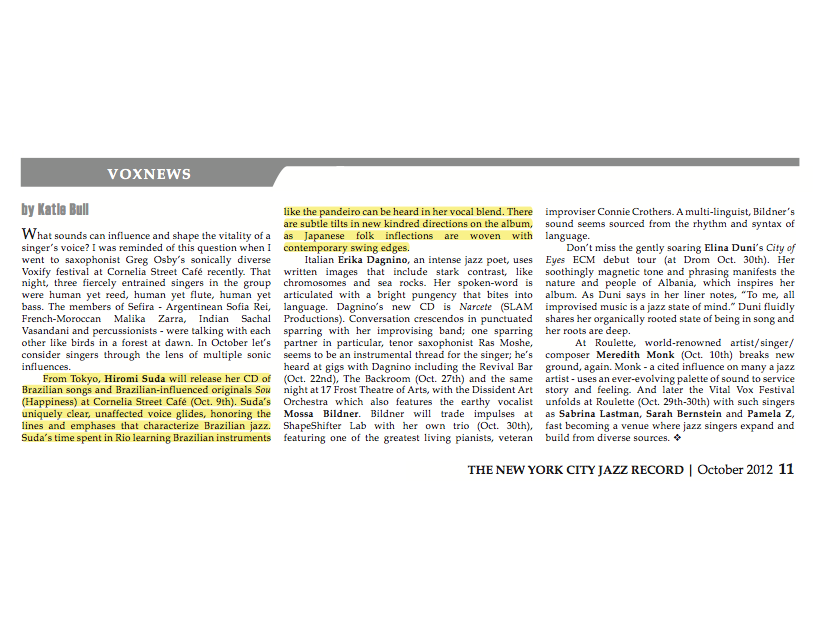
Jazz Life 8/11/2012
Jazz Life 9/14 (Interview)
Jazz Japan 9/2012
LaTina 9/2012
Music Magazine 9/2012
Sunday Mainichi (Interview) (Aug. 28th 2012)
Oz Magazine 8/10/2012
intoxicate (Interview) 8/20/2012
Yamanashi Nichinichi Newspaper (Bunkura) 8/28/2012(Interview)
Tokyo headline 8/27/2012
The article about vocalist/composer Hiromi Suda has been printed in the NY Japanese community magazine called
"American Dream"(Feb. 2013).
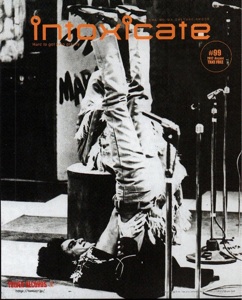
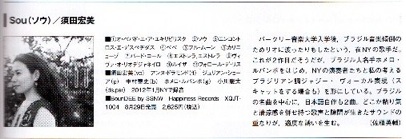
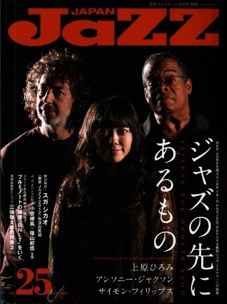
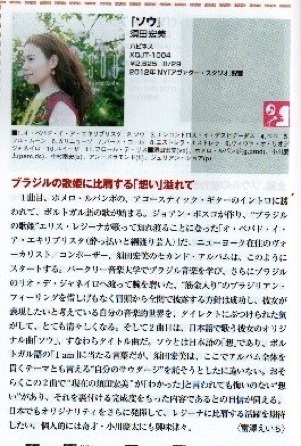
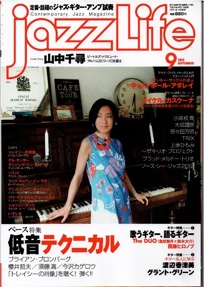

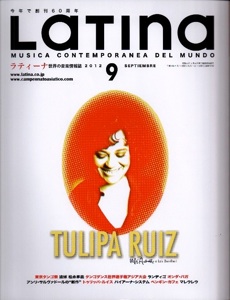
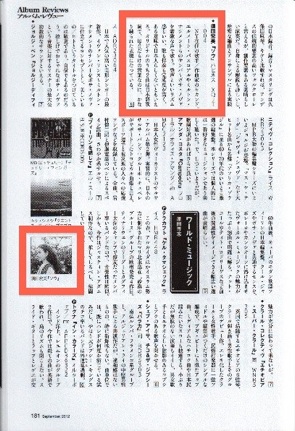
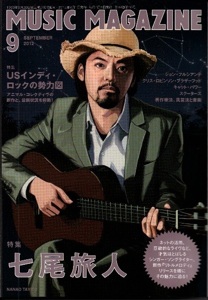
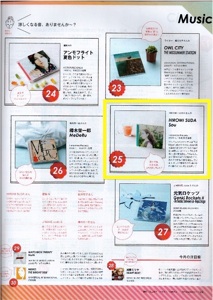
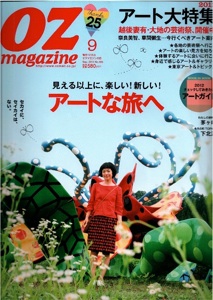
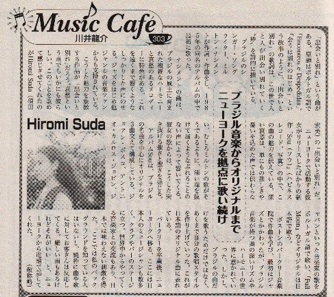


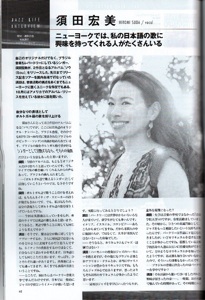

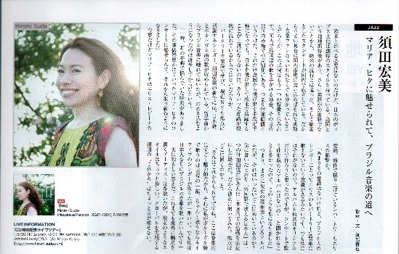
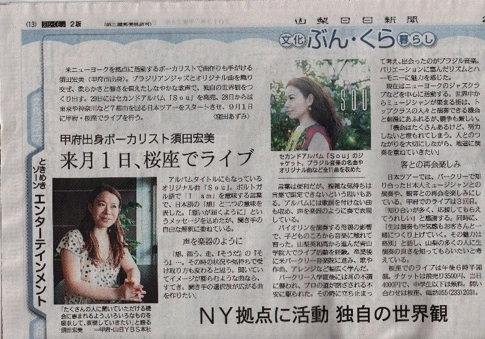
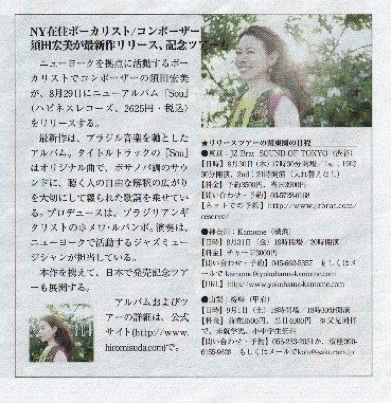
雑誌や新聞にインタビューやニューアルバム"Sou"のレビューなどが掲載されました。
(雑誌/Magazines)
Oz Magazine オズマガジン 8/10号 p.122 http://www.ozmall.co.jp/ozmagazine/
Jazz Life ジャズライフ 8/11号 p.82,98
サンデー毎日 8/28号 (インタビュー/Interview)
LaTina (ラティーナ) 9月号 p.98
Music Magazine 9月号 p.181 (レビュー)
intoxicate 8/20号 p.22(インタビュー/Interview)
ジャズライフ 9/14号 (インタビュー/Interview)
Jazz Japan 9/2012
新聞
山梨日日新聞 8/28朝刊”ぶんくら”(Interview)
Tokyo headline 8/27号

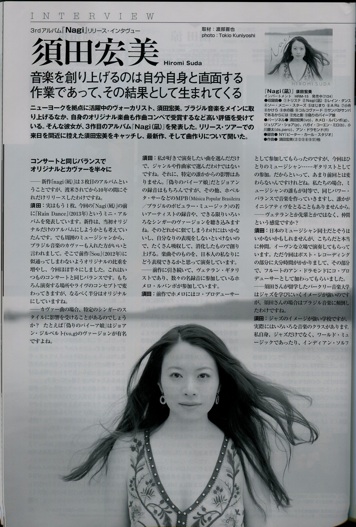
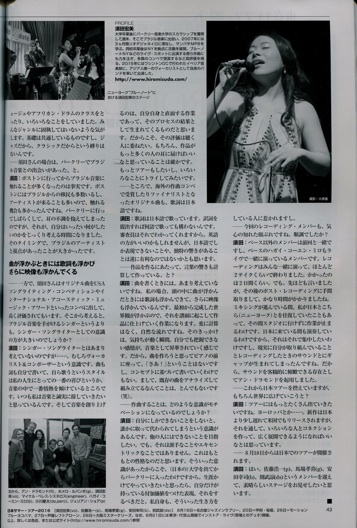
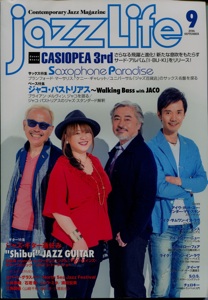
The article and interview from Magazine “Jazz Life” September 2016
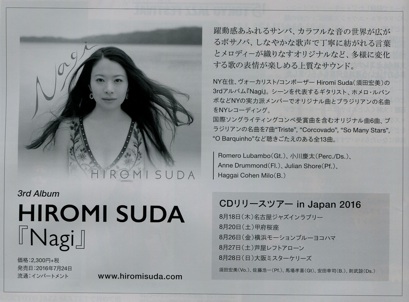
2nd Album “Sou”
3rd album “Nagi”
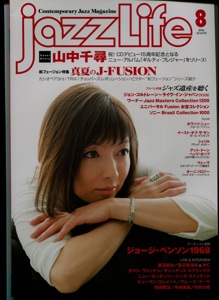
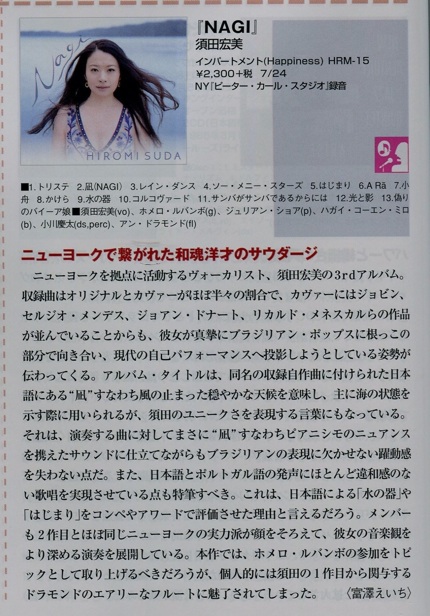
The review about 3rd album “Nagi” from Magazine “Jazz Life” August 2016
“Mikiki” interview page: http://mikiki.tokyo.jp/articles/-/11758
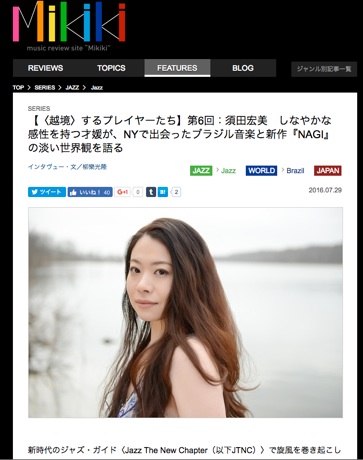
Midwest record
http://www.midwestrecord.com/MWR1183.html
“INPARTMENT
HIROMI SUDA/Nagi: The dexterous Anne Drummond is just the right cat to back up a jazz vocalist that's bridging cultures with her Japanese/Brazilian fusion. Kicking things off with some Jobim, it sets a Brazilian flavored set in motion that by the time Suda goes Japanese on us, it feels like just another indigenous Brazilian tangent because the jazzbos on board have set the mood just right. A tasty diversion that's more right down the middle than you might realize, this is most assuredly an unexpected treat. Well done.”
Salt Peanuts
http://salt-peanuts.eu/record/hiromi-suda/
“«Nagi»
BLUJAZZ PROD. HRM 15
Vokalisten Hiromi Suda kommer fra Yamanishi i Japan, er et totalt ubeskrevet blad for undertegnede. Men på internettet kan man blant annet lese at hun har vært finalist i en reke sangkonkurranser, og at hun har studert på Berklee. Hun har i flere år vært opptatt av brasiliansk musikk, og at hennes første plate kom i 2008.
På hennes plate «Nagi» samarbeider hun med fløytisten Anne Drummond, gitaristen Romero Lubambo, pianisten Julian Shore, bassisten Haggai Cohen-Milo og trommeslageren og perkusjonisten Keita Ogawa. Noen av låtene har Suda laget selv, men hun har også med låter av Antônia Carlos Jobim, Sergio Mendes, João Donato, Roberto Manescali, Ceatano Veloso og Geraldo Pereira.
Det fører til at musikken er svært spredt stilmessig. Vi får noen latinlåter, godt blandet sammen med det japanske, noe som gjør platen til en litt forvirrende opplevelse.
Suda synger med en klar stemme, som ikke har spesielt mye særpreg, og musikerne gjør akkurat det de er satt til. «Kompet» er helt ok, men jeg klarer ikke å bli fortrolig med fløytespillet, som, ved siden av gitaren, er det ledende solistinstrumentet.
Jobim-låtene «Triste» og «Corcovado» er gjort mange ganger bedre tidligere, men hennes egne, låter er de som fungerer klart best, særlig de japansk-inspirerte. Det latinske blir for slapt og fesent til at det fester seg.
Dette er blitt en plate som ikke kommer til å bli ihjelspilt i heimen. Den er for «amatørmessig» og oppfyller ikke kravene man må få lov til å stille til en plateutgivelse i 2017. Dessverre. Jan Granlie
Hiromi Suda (v), Anne Drummond (fl), Romero Lubambo (g), Julian Shore (p, keys), Haggai Cohen-Milo (b), Keita Ogawa (dr, perc)”
The New York City Jazz Record (March 2017) by Tom Greenland
Nagi Hiromi Suda (Blujazz)
“Japan has long been home to some of the world’s greatest jazz fans so it’s only fitting that the nation’s artists now improvise for a global audience.
Vocalist Hiromi Suda hails from Yamanishi. Nagi continues in the vein of her earlier work by paying homage to great Brazilian composers, but also brings more of her original songs and vision to the fore. The covers are greatly aided by Romero Lubambo’s supple acoustic guitar and Anne Drummond’s lithe flute, but the principal attraction is Suda’s voice: clarion-toned, with little or no vibrato, exuding a youthful exuberance belying the somber lyrics. One senses she understands these songs’ deeper sentiments and that her youthfulness doesn’t equate to naïveté. Her own songs, sung in a breathier style reminiscent of folk-rockers like Joni Mitchell, round out the other half of the set. English translations of the Japanese lyrics reveal her affinity for poetic allusion and understated nostalgia.”
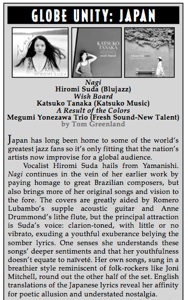
Copyright © 2008 Hiromi Suda All rights reserved.
DownBeat Magazine 2017 May
Latin Jazz Corner http://www.latinjazzcorner.com/2017/04/05/latin-jazz-conversation-hiromi-suda/
Latin Jazz Conversation: Hiromi Suda by CHIPBOAZ on APRIL 5, 2017
Vocalist Hiromi Suda has found something that many jazz musicians spend years talking about but never capturing – a true cross cultural musical blend that digs deep into diverse musical territories. Growing up in Japan, Suda spent time learning the basics of her craft in her musical family while pursuing a musical education at every turn possible. Inspired to make her way as a professional musician, Suda moved to the United States, settling in Boston to attend the Berklee College Of Music. While there, she discovered the beauty of Brazilian music, which inspired her to travel to Brazil and connect with the music on an authentic level. Returning to Boston, Suda dug deeply into the music, performing with flautist Fernando Brandao, pianist Clarice Assad, and more. She later made her home New York, where she met even more Brazilian musicians, including guitarist Romero Lubambo. As Suda progressed in her art, all of the pieces of her background came together into a unique musical approach.
Suda just released her third recording, Nagi, a mature musical statement which puts her distinct approach to composition and performance on display. Singing in Portuguese, English, and Japanese, Suda fluidly moves between musical worlds. In other hands, these influences might clash; in Suda’s care, they seem like branches of the same tree. Presenting a repertoire that includes original music, as well as songs from Antonio Carlos Jobim, Caetano Veloso, and more, Suda gracefully delivers an intriguing musical statement. It’s a wonderful album that needed some more time here at LJC, so Suda took some time recently to answer a few questions about her background, her music, and the creation of Nagi.
Latin Jazz Corner: It seems like you had a musical childhood – what are your early memories of being involved of music?
Hiromi Suda: My mother was a violinist so I have memories with her that we played music together. She played the piano and I sang – she played notes and I answered which notes were they (ear training). She also played the violin for me. I played the piano and composed songs that I showed her. Most of the childhood memories with my mother are with music.
LJC: How did you get involved in jazz and how did you start to learn the style when you were still young?
HS: I had a chance to meet a jazz vocalist when I was junior hight school student and I started to take voice lessons with her. And I also met a film music composer who graduated from Berklee. There was no YouTube when I was young, so it was not easy to get information and recordings like you can now; but I leaned from musicians who I met and CDs. After I entered the university in Tokyo, I started to sing more jazz.
LJC: You discovered Brazilian music when you were at Berklee; what was it about the music that grabbed your attention?
HS: It’s a long story…
Before coming to Boston, I listened to Brazilian musicians such as Elis Regina. But I got into Brazilian music more when I moved to Boston from Tokyo. I had an ear problem when I had just entered Berklee. At that time I had to re-think what I really wanted to do with music since it took a whole semester to find the right doctor who could solve my problem. Whole my first semester at Berklee, I had a hard time until I met the right doctor. After taking the right treatment, I recovered from my illness. Before I got that treatment though, I couldn’t hear lower sounds and I had ear pain. The scariest thing was that I didn’t know why it was happening; I didn’t know if I would recover or get worse. In the mean time, it was hard to listen to music since the balance of my hearing was weird. There was a concert by a Brazilian singer at Berklee and my Brazilian friend asked me to watch the show. I went to the concert and I was so surprised that her voice sounded like Elis Regina. I told my friend about it and my friend said that the singer was the daughter of Elis; her name was Maria Rita. I was moved by Maria Rita’s performance and I started to discover more about Brazilian music. Brazilian music is so deep – all of the rhythmic variations, the different styles from different parts of Brazil, and the music from different times. This attracted me to the music a lot and I got more into Brazilian music.
LJC: This led to time in Brazil studying the music with a variety of Rio musicians – what did this experience do for your commitment to Brazilian music?
HS: Before I’m going to Brazil, I was really into Brazilian music, but I didn’t have many chances to listen to the live “Brazilian” concerts in Boston. In Rio, I had wonderful experiences; every night music were happening. I could go to the concerts by musicians that I really wanted to hear live – Gilberto Gil, Marisa Monte, Toquinho and so on. I could also meet wonderful musicians to play with. I got even more got into Brazilian music through these experiences.
LJC: Since returning from your time in Brazil, you’ve got the opportunity to play with a number of Stateside Brazilian musicians – who are some of the musicians that helped you deepen your understanding of the music back here in the States?
HS: Other musicians and Brazilian friends helped me to understand more about Brazilian culture. Playing with wonderful Brazilian guitarist, Romero Lubambo has always been a wonderful experience as a musician and I learn from him a lot. Also, playing with pianist/composer, Clarice Assad was great experience.
LJC: Nagi is your third album and it reflects your most mature musical concept yet. What do you think has evolved in your music at this point that stands out as unique?
HS: I think my background making my music is unique. I grew up in Japan, and then I moved to Boston to study music. While I was there, I met and played musicians from all over the world – we shared the music beyond our different backgrounds. I went to Brazil to learn about both Brazilian music and culture. Then I moved to New York to focus on my own music style with musicians from lots of different nationalities, languages and gender.
LJC: You write with a combination of cultural elements – Japanese lyrics, jazz harmonies, and Brazilian rhythms play a part at different times in your original music. What are the musical considerations that you take into account when writing with all these elements?
HS: My original music comes naturally to me. I hear the songs in my mind first, and then I write the score to what I’m hearing. Ideas for lyrics and music come into my mind at the same time. I try to just feel the music that I hear in my mind. I’m not trying to put all the cultural elements together together on purpose; they all blend into my music because of my background, I think. (Japan, Brazil, Boston and New York) Of course I polish the musical ideas after they come up. So far, that’s how I’ve been writing my music.
LJC: Lyrics play an important part in your music – what do you look for in a song’s lyrics when you’re interpreting a piece of music?
HS: I try to have my own interpretations when I sing songs of other composers. I research the original meaning first, but I always try to find my own way to understand and express the songs. I try to find the way that only I can express the songs. If I’m singing samba I try to think how I can express the song and remain myself even though other people wrote it. I try to sing samba just as I would Japanese and I try to being myself. I’m not trying to be Brazilian or someone else.
LJC: You’ve got a fantastic group on Nagi – what do your musicians bring to the experience of shaping your approach to the music?
HS: We have been playing together for a while and I know their sound. I just expected them to be themselves and play their sounds. They are also just trying to feel my music. I always appreciate that I can make music with such wonderful musicians.
LJC: Having explored so many musical avenues at this point, what would you like to do next musically?
HS: I would like to work more on my original music. I would like to make an album with all original music.
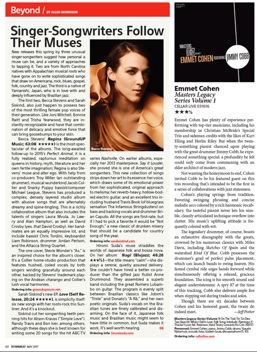
Jazz Quad http://jazzquad.ru/index.pl?act=PRODUCT&id=4662
Hiromi Suda - Nagi
стиль: джаз 13.04.2017
Японская певица и автор песен Хироми Суда выросла в музыкальной семье, увлеклась музыкой с детства, но, останься она на родине, вряд ли ее творчество приобрело бы столь необычный и даже уникальный характер. Джаз был особенно интересен Суда, и она отправилась продолжать образование в ведущий мировой центр – колледж Беркли в Бостоне. Именно там, совершенствуясь в технике джазового вокала она, неожиданно для себя, открыла красоту бразильской музыки. Изучать ее японка отправилась в Рио-де-Жанейро, а вернувшись затем в Штаты, заняла особую нишу, сочетая в своем творчестве исполнение музыки ведущих мастеров бразильской босса-новы и самбы и собственные сочинения, основательно замешанные на японском фольклоре и поп-музыке, делая все это на солидной джазовой основе.
Новый, третий по счету, альбом Хироми под названием Nagi, демонстрирует своеобразие ее искусства в полной мере. Альбом состоит из солидной коллекции бразильских мелодий, вещей Жобима (Triste, Corcovado), Каэтано Велозо (Desde Que O Samba É Samba), Серхио Мендеса (So Many Stars) и других авторов, вкупе с шестью собственными песнями Хироми Суда. О их качестве можно судить хотя бы потому, что композиция Hajimari попала в число финалистов ежегодно вручаемой в США премии в области акустической музыки, а Mizu no Utsuwa не только была в таком же финале годом ранее, но и удостоилась в 2013 году почетной награды на всеамериканском конкурсе песни. Поет Суда на трех языках – португальском, великолепно воспроизводя светлую грусть бразильских мелодий, японском, нежно и лирично, и на английском, играющем роль этакого связующего в этой интернациональной смеси.
Интернационален и состав аккомпанирующего певице ансамбля, собранного из живущих в космополитичном Нью-Йорке музыкантов. Пожалуй, главными ее ассистентами можно назвать американскую флейтистку Энни Драммонд и бразильского гитариста Ромеро Лубамбо. Команду дополняет ритм-группа, состоящая из американского пианиста Джулиана Шора, израильского басиста Хаггая Коэн-Мило и земляка Хироми, барабанщика Кейта Озава. Все они, кроме израильтянина, работали с Хироми на ее предыдущем альбоме, спродюсированном Лубамбо. На этот раз роль продюсера взяла на себя Драммонд. Впрочем, чистым аккомпанементом назвать равботу этих музыкантов было бы несправедливо. Достаточно прислушаться к игре Ромеро во всех бразильских треках, флейте Энни в Triste, Kakera или титульной композиции, фортепьяно Джулиана в Hikari to Kage или басовым линиям Хаггая в той же Kakera, чтобы оценить и мастерство музыкантов, и уровень их взаимопонимания с певицей.
Бразильско-японский коктейль от Хироми Суда экзотичен, но отличается тонким вкусом, насышенным ароматом, согревает дущу и поднимает тонус. Попробуйте сами!
© & (p) 2017 Blujazz
13 tks / 46 mins
(Hiromi Suda – voc; Anne Drummond – fl; Romero Lubambo – g; Julian Shore - p, keyb; Haggai Cohen-Milo – b; Keita Ogawa – dr, perc;)
Hiromi Suda’s muse straddles the worlds of Japanese folk and bossa nova. On her album Nagi (Blujazz; 46:26 ★★★1⁄2)—the title means “calm”—she dis- plays a serene, quietly assured delivery. She couldn’t have hired a better co-pro- ducer than the gifted jazz flutist Anne Drummond. They assembled a superb band including the great Romero Lubam- bo on guitar. The program is evenly split between Brazilian classics like Jobim’s “Triste” and Donato’s “A Rã,” and her own poetic originals. Suda’s vocals on the Bra- zilian tunes are finely calibrated and dis- arming. On the face of it, Japanese folk music and Brazilian music might seem to have little in common, but Suda makes it work. It’s well worth hearing.DB Ordering info: hiromisuda.com
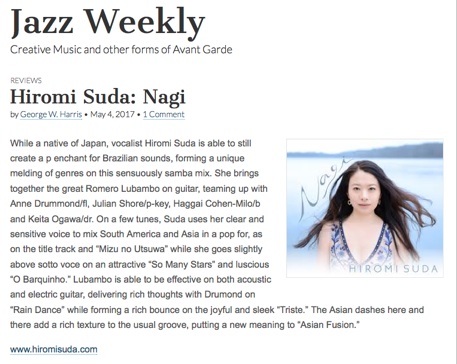
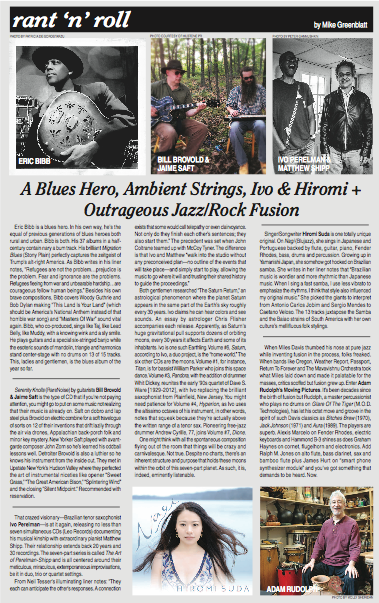
A review in Aquarian Weekly:
“rant ‘n’ roll by Mike Greenblatt
Singer/Songwriter Hiromi Suda is one totally unique original. On Nagi (Blujazz), she sings in Japanese and Portuguesebackedbyflute,guitar,piano,Fender Rhodes, bass, drums and percussion. Growing up in Yamanishi Japan, she somehow got hooked on Brazilian samba. She writes in her liner notes that “Brazilian music is wordier and more rhythmic than Japanese music. When I sing a fast samba, I use less vibrato to emphasize the rhythms. I think that style also influenced my original music.” She picked the giants to interpret from Antonio Carlos Jobim and Sergio Mendes to Caetano Veloso. The 13 tracks juxtapose the Samba and the Baiao strains of South America with her own culture’s mellifluous folk stylings.
Jazz Weekly
Hiromi Suda: Nagi
by George W. Harris • May 4, 2017
While a native of Japan, vocalist Hiromi Suda is able to still create a p enchant for Brazilian sounds, forming a unique melding of genres on this sensuously samba mix. She brings together the great Romero Lubambo on guitar, teaming up with Anne Drummond/fl, Julian Shore/p-key, Haggai Cohen-Milo/b and Keita Ogawa/dr. On a few tunes, Suda uses her clear and sensitive voice to mix South America and Asia in a pop for, as on the title track and “Mizu no Utsuwa” while she goes slightly above sotto voce on an attractive “So Many Stars” and luscious “O Barquinho.” Lubambo is able to be effective on both acoustic and electric guitar, delivering rich thoughts with Drumond on “Rain Dance” while forming a rich bounce on the joyful and sleek “Triste.” The Asian dashes here and there add a rich texture to the usual groove, putting a new meaning to “Asian Fusion.”


